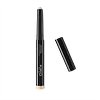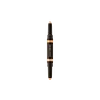KIKO Milano Universal Stick Concealer Versus Laura Mercier Secret Camouflage Brighten And Correct Duo
What's inside
What's inside
 Key Ingredients
Key Ingredients

 Benefits
Benefits

 Concerns
Concerns

 Ingredients Side-by-side
Ingredients Side-by-side

Caprylic/Capric Triglyceride
MaskingButylene Glycol Dicaprylate/Dicaprate
EmollientDicalcium Phosphate
AbrasivePolyethylene
AbrasiveSynthetic Wax
AbrasiveBehenyl Dimethicone/Bis-Vinyldimethicone Crosspolymer
EmollientPolymethylsilsesquioxane
Polyglyceryl-2 Isostearate/Dimer Dilinoleate Copolymer
EmollientStearalkonium Hectorite
Gel FormingPolyhydroxystearic Acid
EmulsifyingC20-24 Olefin
Skin ConditioningPropylene Carbonate
SolventPentaerythrityl Tetra-Di-T-Butyl Hydroxyhydrocinnamate
AntioxidantMica
Cosmetic ColorantCI 77891
Cosmetic ColorantCI 77492
Cosmetic ColorantCI 42090
Cosmetic ColorantCaprylic/Capric Triglyceride, Butylene Glycol Dicaprylate/Dicaprate, Dicalcium Phosphate, Polyethylene, Synthetic Wax, Behenyl Dimethicone/Bis-Vinyldimethicone Crosspolymer, Polymethylsilsesquioxane, Polyglyceryl-2 Isostearate/Dimer Dilinoleate Copolymer, Stearalkonium Hectorite, Polyhydroxystearic Acid, C20-24 Olefin, Propylene Carbonate, Pentaerythrityl Tetra-Di-T-Butyl Hydroxyhydrocinnamate, Mica, CI 77891, CI 77492, CI 42090
Isodecyl Neopentanoate
EmollientPolymethylsilsesquioxane
Polyethylene
AbrasivePropylene Glycol Dicaprylate/Dicaprate
EmollientHdi/Trimethylol Hexyllactone Crosspolymer
Isononyl Isononanoate
EmollientDicalcium Phosphate
AbrasiveSynthetic Wax
AbrasiveOctyldodecanol
EmollientNelumbo Nucifera Flower Extract
Skin ConditioningPentaerythrityl Tetra-Di-T-Butyl Hydroxyhydrocinnamate
AntioxidantCaprylic/Capric Triglyceride
MaskingPolyhydroxystearic Acid
EmulsifyingIsostearic Acid
CleansingPolyglyceryl-3 Polyricinoleate
EmulsifyingLecithin
EmollientPhytosphingosine
Skin ConditioningDimethicone/Vinyl Dimethicone Crosspolymer
Skin ConditioningLaureth-4
EmulsifyingC30-45 Alkyl Dimethicone
Skin ConditioningCetyl Dimethicone
EmollientDimethicone
EmollientDisteardimonium Hectorite
StabilisingPropylene Carbonate
SolventSqualane
EmollientPhenyl Trimethicone
Skin ConditioningDipentaerythrityl Hexahydroxystearate/Hexastearate/Hexarosinate
Skin ConditioningDipentaerythrityl Hexahydroxystearate
EmulsifyingCopernicia Cerifera Cera
EmollientDiacetyl Boldine
Skin ConditioningAstrocaryum Murumuru Seed Butter
EmollientTocopherol
AntioxidantAlcohol Denat.
AntimicrobialWater
Skin ConditioningBlue 1 Lake
Cosmetic ColorantCI 77491
Cosmetic ColorantCI 77492
Cosmetic ColorantCI 77499
Cosmetic ColorantCI 77891
Cosmetic ColorantCI 77007
Cosmetic ColorantMica
Cosmetic ColorantCI 42090
Cosmetic ColorantIsodecyl Neopentanoate, Polymethylsilsesquioxane, Polyethylene, Propylene Glycol Dicaprylate/Dicaprate, Hdi/Trimethylol Hexyllactone Crosspolymer, Isononyl Isononanoate, Dicalcium Phosphate, Synthetic Wax, Octyldodecanol, Nelumbo Nucifera Flower Extract, Pentaerythrityl Tetra-Di-T-Butyl Hydroxyhydrocinnamate, Caprylic/Capric Triglyceride, Polyhydroxystearic Acid, Isostearic Acid, Polyglyceryl-3 Polyricinoleate, Lecithin, Phytosphingosine, Dimethicone/Vinyl Dimethicone Crosspolymer, Laureth-4, C30-45 Alkyl Dimethicone, Cetyl Dimethicone, Dimethicone, Disteardimonium Hectorite, Propylene Carbonate, Squalane, Phenyl Trimethicone, Dipentaerythrityl Hexahydroxystearate/Hexastearate/Hexarosinate, Dipentaerythrityl Hexahydroxystearate, Copernicia Cerifera Cera, Diacetyl Boldine, Astrocaryum Murumuru Seed Butter, Tocopherol, Alcohol Denat., Water, Blue 1 Lake, CI 77491, CI 77492, CI 77499, CI 77891, CI 77007, Mica, CI 42090
Ingredients Explained
These ingredients are found in both products.
Ingredients higher up in an ingredient list are typically present in a larger amount.
This ingredient is an emollient, solvent, and texture enhancer. It is considered a skin-softener by helping the skin prevent moisture loss.
It helps thicken a product's formula and makes it easier to spread by dissolving clumping compounds.
Caprylic Triglyceride is made by combining glycerin with coconut oil, forming a clear liquid.
While there is an assumption Caprylic Triglyceride can clog pores due to it being derived from coconut oil, there is no research supporting this.
Learn more about Caprylic/Capric TriglycerideCi 42090 is a synthetic dye created from petroleum. It is used to give a bright blue color to cosmetics, medicine, and food.
Ci 77492 is also hydrated iron III oxide. It's sole purpose is to give a yellow hue to products.
Iron III oxides are classified as inorganic chemicals for coloring.
Synthetically created Ci 77492 is considered safer than those naturally found. This is because the synthetically created version may contain less impurities. Iron oxides are generally non-toxic and non-allergenic.
Learn more about CI 77492Ci 77891 is a white pigment from Titanium dioxide. It is naturally found in minerals such as rutile and ilmenite.
It's main function is to add a white color to cosmetics. It can also be mixed with other colors to create different shades.
Ci 77891 is commonly found in sunscreens due to its ability to block UV rays.
Learn more about CI 77891Dicalcium Phosphate is an exfoliant.
Mica is a naturally occurring mineral used to add shimmer and color in cosmetics. It can also help improve the texture of a product or give it an opaque, white/silver color.
Serecite is the name for very fine but ragged grains of mica.
This ingredient is often coated with metal oxides like titanium dioxide. Trace amounts of heavy metals may be found in mica, but these metals are not harmful in our personal products.
Mica has been used since prehistoric times throughout the world. Ancient Egyptian, Indian, Greek, Roman, Aztec, and Chinese civilizations have used mica.
Learn more about MicaPentaerythrityl Tetra-Di-T-Butyl Hydroxyhydrocinnamate (long name, huh?) is a synthetic antioxidant.
It is used to help stabilize other antioxidants or prevent the color from changing in a product.
As an antioxidant, it helps fight free-radical molecules. Free-radical molecules are capable of damaging our cells and other genetic material. Thus, antioxidants may reduce the signs of aging.
This ingredient is oil-soluble.
Learn more about Pentaerythrityl Tetra-Di-T-Butyl HydroxyhydrocinnamatePolyethylene is a synthetic ingredient that helps the skin retain moisture. It is a polymer.
It is also typically used within product formulations to help bind solid ingredients together and thicken oil-based ingredients. When added to balms and emulsions, it helps increase the melting point temperature.
Polyhydroxystearic Acid is a soft wax made from castor oil.
It is is a texture thickener, emulsifier, and film-former. Emulsifiers prevent ingredients from separating, such as oils and waters.
Polyhydroxystearic Acid may not be fungal acne safe.
Learn more about Polyhydroxystearic AcidPolymethylsilsesquioxane is a silicone used as a film forming agent.
When applied to the skin, this ingredient creates an invisible film on the surface. This film still allows oxygen to pass through, but prevents moisture from escaping. This can help condition and hydrate the skin. It also leaves a silky feel when applied.
Polymethylsilsesquioxane has not been shown to clog pores. It has been deemed safe to use up to 55%, but most cosmetics use much less.
If you have concerns about using this ingredient, we recommend speaking with a professional.
Learn more about PolymethylsilsesquioxaneThis ingredient is a solvent. It helps dissolve active ingredients and alter the texture of products.
Propylene Carbonate is commonly used in makeup and with clay, such as montmorillonite or bentonite.
Studies show this ingredient to be safe for cosmetics. When it is undiluted, it can cause skin irritation. (It is always diluted in skincare and makeup). This ingredient is water-soluble.
Propylene Carbonate is created from propylene glycol and carbonic acid.
Learn more about Propylene CarbonateSynthetic Wax is created from fossil fuels such as natural gas. It is used to enhance texture, adjust pH, and as an occlusive.
It may also be used as an abrasive ingredient to exfoliate the skin.
Synthetic Wax may not be fungal acne safe.
Learn more about Synthetic Wax